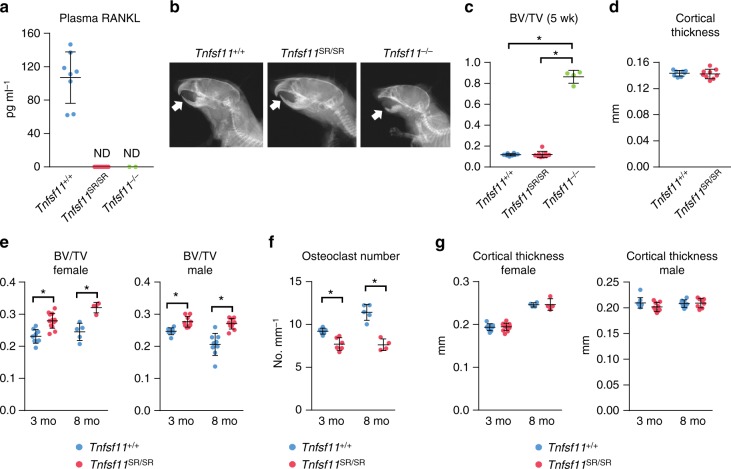Fig. 2.
Soluble RANKL contributes to osteoclast formation in adult mice. a sRANKL levels in the blood plasma of 5-week-old Tnfsf11+/+ (n = 8), Tnfsf11SR/SR (n = 9), and Tnfsr11−/− (n = 2) mice. ND not detectable. b X-ray images from 5-week-old Tnfsf11+/+, Tnfsf11SR/SR, and Tnfsr11−/− mice. Arrowheads indicate position of lower incisors. c Cancellous bone volume of L4 vertebra from 5-week-old Tnfsf11+/+ (n = 8), Tnfsf11SR/SR (n = 9), and Tnfsr11−/− (n = 4) mice. *P < 0.05 versus Tnfsf11+/+ or Tnfsf11SR/SR mice using one-way ANOVA. d Cortical thickness of femurs from 5-week-old Tnfsf11+/+ (n = 8) and Tnfsf11SR/SR (n = 9) mice. e Cancellous bone volume of L4 vertebra from 3-month-old female Tnfsf11+/+ (n = 9) and Tnfsf11SR/SR (n = 13) and male Tnfsf11+/+ (n = 8) and Tnfsf11SR/SR (n = 9) mice and 8-month-old female Tnfsf11+/+ (n = 5) and Tnfsf11SR/SR (n = 4) and male Tnfsf11+/+ (n = 9) and Tnfsf11SR/SR (n = 10) mice. *P < 0.05 versus Tnfsf11+/+ mice using Student’s t test. f Osteoclast number per mm bone surface measured in the cancellous bone of L1–L3 vertebra of 3-month-old Tnfsf11+/+ (n = 6) and Tnfsf11SR/SR (n = 6), and 8-month-old Tnfsf11+/+ (n = 5) and Tnfsf11SR/SR (n = 4), female littermates. *P < 0.05 using Student’s t test. g Cortical thickness of femurs from 3-month-old female Tnfsf11+/+ (n = 9) and Tnfsf11SR/SR (n = 13) and male Tnfsf11+/+ (n = 9) and Tnfsf11SR/SR (n = 9) mice and 8-month-old female Tnfsf11+/+ (n = 5) and Tnfsf11SR/SR (n = 4) and male Tnfsf11+/+ (n = 9) and Tnfsf11SR/SR (n = 10) mice. All analyses of 5-week-old mice included both sexes. All values are means ± s.d.

